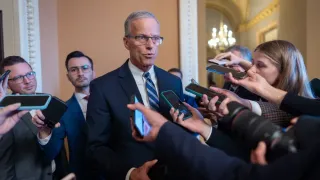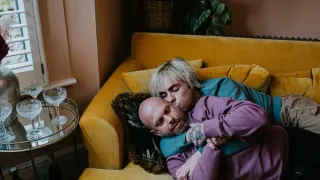August 9, 2022
George Platt Lynes' 'Daring Eye'- New Biography on Pioneering Gay Photographer
Robert Brokl READ TIME: 6 MIN.
George Platt Lynes is known, in certain educated circles, as the photographer of fashion, ballet dancers, cultural icons, and male nudes, anthologized in surveys of gay art and photography, like "Hide/Seek."
But Allen Ellenzweig's important new book, "George Platt Lynes: the Daring Eye," reveals far more about Lynes and his times, nearly seven decades since his untimely death of lung cancer in 1955, at 48. Ellenzwieg had the cooperation of the Lynes family for this biography, including access to the manuscript written by his late brother, Russell Lynes, from 1988, about his brother.
But the book is no "authorized" hagiography, nor is it dishy or prurient. Instead, Ellenzweig artfully traces Lynes' origins in New Jersey, son of a minister of a well-to-do congregation, with sophisticated tastes and a decorator wife. (Lynes appended the Platt to Lynes, perhaps as an act of sibling rivalry, but also linking him to an ancestor, mid-19th-century New York City interior designer, also named George. Names are destiny.)
Young Lynes was sent off to the Berkshire School for Boys in Massachusetts, an expensive private school. His parents hoped the headmaster might de-sissify him. Indeed, an older classmate, and lifelong bisexual, Lincoln Kirstein, kept a careful, disapproving distance, although later he and Lynes would develop an important collaboration, with Lynes photographing the dancers of the New York City Ballet, the company Kirstein and George Balanchine founded.
The young Lynes is described as precocious, stubborn, and willful, with writing ambitions. He successfully cultivated Gertrude Stein and Alice Toklas, ultimately gaining access to their circle and visiting them in France. With more ambition than resources, he published essays by Stein, and later took the Roman emperor-like portrait of Stein that appeared the cover of Time. Stein, in her transactional fashion, appreciated his efforts on her behalf.
Lynes was a catch. His blond hair turned gray early, earnng him the "silver fox" nickname. He exercised, was suave. We're told female fashion model subjects were disappointed to learn he was gay. Despite financial ups and downs, he maintained elegant studio and living spaces, dressed well, and liked entertaining. He's articulate and literate in his correspondence, even successfully negotiating the purge of other male gays by Stein and Toklas from their circle.
Encounters
Equally fortuitous, through the Stein connection, he made the life-altering meeting with the older, more sophisticated, and worldly couple, novelist Glenway Wescott; and publisher and later New York Museum of Modern Art curator Monroe Wheeler.
During the meeting with Wescott, Lynes had a coupe de foudre experience: Spotting a photograph of Wheeler, he announced, "That's the man for me." Wescott went along, and both were helpful to his career. They suggested photography to Lynes. They maintained this sometimes difficult menage-a trois for eleven years, Lynes noting in code in his journal when he slept with each of them.
His circle included another artist menage-a-trois, the "Pajama" threesome of Margaret and Jared French, and Paul Cadmus. ("Pajama" combines the first two letters of their names.) They all painted and photographed each other. French painted a triptych of Wheeler, Westcott, and Lynes nude, and Cadmus painted the psychologically-revealing group portrait "Stone-blossom: A Conversation Piece."
As a photographer for Condé-Nast, Lynes specialized in images for advertising and fashion spreads. His fashion photography is notable for its elegant arrangements and dramatic, theatrical lighting. Similar staging and mis-en-scene characterized his surrealist images, involving dancers and props. Under the guise of artful fantasy, his use of male nudity got a pass, and was shown in galleries and museums.
Of more lasting importance as documentation, Lynes photographed his friends and contemporaries: Stein, Toklas, Virgil Thompson, Kirstein, Andre Gide, Marianne Moore, Jean Cocteau, Christopher Isherwood and Don Bachardy, Marsden Hartley (with whom he briefly shared his studio), movie stars Katherine Hepburn and Burt Lancaster.
The candid male nudes Lynes took from his twenties on were for his private enjoyment, at the end of formal shoots, of friends and acquaintances, dancers. They were shared with friends, but carefully, since "pornography" could not be sent through the mail, and homosexuality was illegal.
In and Out of Fashion
In 1949, Lynes made two fateful encounters: E. M. Forster and Alfred Kinsey. He photographed Forster and his married-to-a-woman policeman boyfriend, Bob Buckingham. Westcott and Wheeler had already become involved with Kinsey, the scientist who "proved" homosexuality was normal and innate. Both submitted to Kinsey's in-depth sexual history interviews, Westcott had a short affair with him, and Lynes allowed Kinsey to observe him having sex.
Most importantly, Kinsey started to buy his photographs for the Institute, sometimes out of his own pocket when Lynes desperately needed money. Lynes's problem was that his commercial photography that paid the bills fell out of fashion. A brief move to Hollywood was a financial disaster, and the return to his natural habitat of Manhattan was rocky.
Lynes befriended longtime Berkeley resident Samuel Steward, a pornography writer and tattoo artist (whose reputation was revived by Justin Spring's book, "Secret Historian.") They corresponded and made visits, Steward even suggesting his handsome Black male sexual partner as a subject for Lynes.
In later years, he survived on loans from friends and relations, undermining the relationship he had with his brother and sister-in-law, the ones he turned to first, even moving in with them for a time.
Lynes was only 48 when he died of lung cancer, but he managed, with great determination, to place many of his prints and negatives with the Kinsey Institute, negotiating that they remain available for the public, not locked away in secret.
Ellenzweig reports Lynes was notoriously apolitical, tuning out during political conversations. Yet his catalog of important gay cultural luminaries and the straightforward depiction of male nudity and beauty, whether youthful acrobats or, from 1942, the leonine Yul Brynner – full frontal, naked but for the full head of hair, posing on a modernist, unpainted plywood bench – are ahead of their time, presciently avoiding Mapplethorpe's calculated provocation and Bruce Weber's shallow clichés.
'George Platt Lynes: the Daring Eye,' by Allen Ellenzweig, Oxford University Press $45 hardcover.
global.oup.com
Help keep the Bay Area Reporter going in these tough times. To support local, independent, LGBTQ journalism, consider becoming a BAR member.






